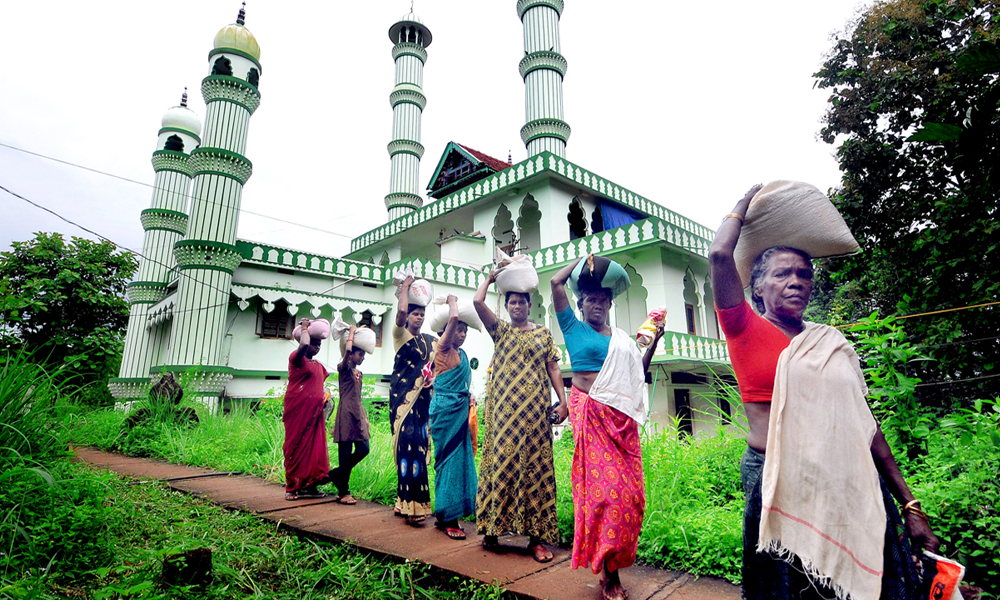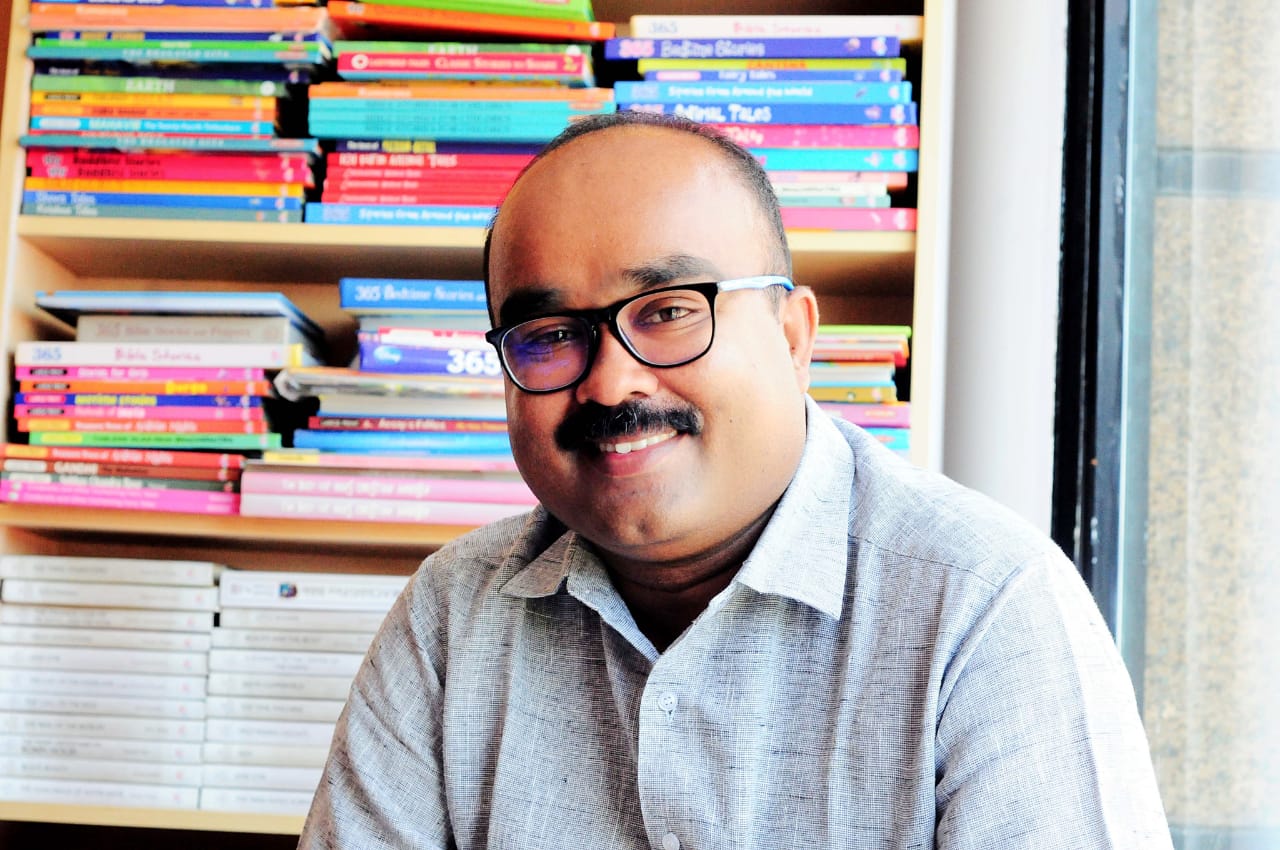For the Muslim residents of Moonnakkal village located on the outskirts of Valanchery town in Kerala's Malappuram district, there is nothing extraordinary about hundreds of women with different religious identities forming long queues in the premises of the local Juma Masjid at least thrice a month.
These women are representing over 28,000 poor families settled in 171 mahals (localities) spread across 21 Gram Panchayats located around Valanchery, and they all are beneficiaries of a unique food security mechanism centred around the mosque for several decades.
As per custom, rich Muslims who reach the Masjid for prayers must donate maximum quantities of fine quality rice as an offering. There are over a dozen rice shops outside the masjid and the devotees can easily buy and donate rice any day depending upon the financial position.
Distribution of free rice is progressing at Moonnakkal Masjid. (Image: Najeeb Shah)
The masjid managing committee has a huge facility outside the mosque for collection and processing of the rice before distributing it free of cost among the chosen families depending upon their monthly needs. Based on a token system, women members of the selected families can reach the masjid premises on specified dates to collect their allocated quota of rice, which is often supplemented with wheat and sugar.
"More than half of our beneficiaries are Hindus and Christians. For us, religion has never been a criterion in enrolling people. For the beneficiary families, there is no need of spending money on food grains," said N Rahmatulla, secretary of masjid administrative committee.
According to P Krishnakumari, who lives in adjacent Kottakkal, people of the region prefer this alternative facility than the public distribution system (PDS) to get rice. The masjid ensures more quality and quantity than the PDS, she said. In addition, the price fluctuation happening at the market is not affecting these families.
Edakkulam is located a little away from Moonnakkal and this Muslim majority village comprises Kerala's lone lotus-growing community. Since a time people of the region can't even remember, lotus flowers tended to by Muslims here have been supplied to all major Hindu temple in Kerala like the Guruvayur Sri Krishna Temple, Thrissur Paramekkavu Temple, Kozhikode Tali Temple and Kadampuzha Bhagavathy Temple.
Edakkulam, a Muslim majority village in Malappuram which cultivates lotuses for the use at temples across Kerala. (Images by Najeeb Shah)
Last year, village resident Chakkalaprambil Musthafa and his neighbours had supplied 112 kilogrammes of lotus flowers to Guruvayur Sri Krishna Temple to perform Prime Minister Narendra Modi's Tulabharam.
As per customs of the temple, Tulabharam is a religious offering in which a person is weighed against a commodity such as flowers, grains, fruits and similar articles and the equal value or quantity is offered as a donation. For Modi, the preference was the party symbol of blooming lotuses. "We have been depending on our Muslim brethren here for lotus flowers on a daily basis at least for the last three centuries. They supply us quality flowers at a nominal rate," said Prakashan Namboothiri, chief priest of the famous Navamukunda Temple at Thirunavaya.
For over three centuries, Malappuram is the favourite target of BJP leader Subramanian Swamy who finds equations to the "pathetic plight of the Hindus in Kashmir" only in the central Kerala district with a Muslim majority. It's of a piece with the numerous canards the Sangh Parivar has been spreading about Malappuram in its cynical attempts to import Indo-Gangetic barbarism into the harmonious social fabric of Kerala. Malappuram, a Muslim-majority (70 per cent) district upstate, is being demonised.
In the 2019 general election, the incumbent Union Home Minister and the then BJP President, Amit Shah, had termed Malapuram, as `Mini-Pakistan.'
Union Home Minister and former Bhartiya Janata Party chief, Amit Shah. (Image: Twitter)
"Malappuram is known for its intense criminal activity," thundered BJP Lok Sabha member and former union minister Maneka Gandhi in a recent tweet wrongly linking residents of the district with the killing of a pregnant elephant by miscreants who suspected to have offered eatables stuffed with firecrackers.
A number of Sangh Parivar leaders and cadres are engaged in a social media campaign across North India terming Malappuram as a 'jihadist hub' full of 'anti-nationals'. In that process, what often gets buried in the pluralistic and cosmopolitan ethos of Malappuram, which evolved over centuries. At the grassroots level, Malappuram is giving a picture completely in contrast with what hate mongers of Sangh Parivar are spreading in North India.
"Amit Shah and Maneka Gandhi might not have heard about the annual festival at Kaliyattakkavu Bhagavathy Temple at Munniyur in Malappuram. Devotees who form part of the festival procession would first go to the Maqbara or mausoleum of Islamic scholar Mamburam Thangal for offering prayers. The procession would reach the temple only after paying respects to Thangal, who was a powerful symbol of Hindu-Muslim unity,'' said Thoppil Shajahan, who directed the short film 'Unseen Malappuram'.
At Thunchanparambu near Tirur, the birthplace of Thunchathu Ezhuthachan, father of Malayalam language and Literature, over 6000 children are getting initiated into the world of letters every year as part of the Vidyarambham ritual. A number of children attending the ritual are from Islamic background. Also curious is the strong presence of Muslim volunteers who supply milk and snacks to attending children.
At Palappuram Masjid in Kottakkal, its famous mimbar is a donation of P S Varier, legendary ayurvedic expert and founder of famous Kottakkal Arya Vaidya Salai.
Till last year, the famous Angadipuram temple and adjacent Perinthalmanna Juma Masjid had a common fireworks expert, who managed crackers and other explosives during annual festivals. T Pariyani, the devout Hindu who won the confidence of the masjid committee, died last year after serving the temple and mosque for over 45 years.
At Puthiyangadi Thangal Makham, offerings like fruits and coconut oil always come from the nearby Pullooni Bhagavathy temple. At Kurumba Bhagavathy temple at Thanur, the appointment of the chief priest must be ratified by a local Muslim landlord family as per the custom.
"For us who live here for generations, the Sangh Parivar allegations are nothing new. We have been hearing concocted stories of communal hatred in Malappuram right from the formation of it 51 years ago," said Faisal Shahab, a college lecturer. With over 70 per cent of the population as Muslims, Malapuram is one of the largest Muslim pockets across India. In South India, it's the lone Muslim majority district.
"Right from its formation in 1969, Hindu fundamentalists have been doing their very best to project Malappuram as Kerala's most violent district. Even mainstream media organisations in other parts of the country have swallowed this theory without conducting any reality check.
Other than communalising the death of the elephant, Maneka Gandhi made several baseless comments against Malapuram in a much-publicised television interview,'' points out human rights activist and filmmaker K P Sasi.
Member of Parliament and animal rights activist, Maneka Gandhi. (Image: Twitter)
"Malappuram is such a district which is perhaps the most disturbed in the whole of India. Every day there is some incident which comes from Malappuram. These people beat animals like anything. The panchayat people there not only abuse elephants, but they also throw poison on the ground, killing thousands of animals, they kill birds, and they kill dogs. Every day there is some killing happening there," she said in the interview given to ANI.
"They kill so many women there," she further claimed, "They have these Hindu-Muslim fights and cut the hands of people. It is a scary situation in Malappuram. It looks like the Kerala government is scared of them. As a result, no sort of action is taken over there. The weakest administrative people are sent to Malappuram. Now the question is, what is the Kerala government going to do?"
However, police authorities in Kerala say the district has less number of crimes such as murder, dowry deaths, rape attempts, murder attempts, extortion, abduction and kidnapping while comparing with other parts of the state.
"Dispelling the negative stereotypes about the district is not an easy task. The hate mongers who were active since the district was carved out of Palakkad and Kozhikode on June 16, 1969, have received a renewed vigour ever since BJP came to power at the centre,'' said M Girish, a Malapuram-based assistant professor of law.
Though Babri Masjid demolition in 1992 had created a large scale belief crisis among Muslims of Malappuram, amity and solidarity are still existing unhindered in Malappuram. No communal riot had happened in Malappuram ever since its formation in sharp contrast to the propaganda outside.
Author Shajahan Madampat. (Image: Facebook)
"The last memories of communal hatred go back as far as the Mappila rebellion of 1921 or the expeditions of Tipu Sultan in the 18th century. Although the agrarian and anti-colonial nature of the former and the expansionist power designs of the latter are not to be disputed as the predominant tropes of the periods, there is no denying the not-so-subtle manifestations of naked Muslim fanaticism that ruled the roost during both the occasions. But it will be unfair not to recognise that the Mappilas of Malabar learned their lessons and never nurtured exclusionary tendencies ever since,'' opines writer and commentator Shajahan Madampat in one of his widely circulated articles on the district.
In all these years, Malappuram has achieved high economic growth largely because of the inflow of funds from expatriates in the Gulf region. The district has heavy stakes in agriculture and infrastructure sectors as well. In the public health sector too, the district has made rapid gains.
"The beauty of Malappuram can be experienced only by those who try to relate with the people of the district. It has a long tradition of communal harmony which is still not recognised properly. To know about a region, its culture, its environment, its traditions and history, it is not necessary that one should have been born or have lived in that region. What is most important is to have a certain degree of openness to understand," opines Sasi, a native of Malappuram who moved later to Bangalore.
"Malappuram has one of the earliest traditions of freedom struggle, right from the beginning of the Portuguese colonial invasion. Most of the heroes of these struggles were Muslims. The contribution of Malappuram to the freedom struggle against the British and its people's contributions to poetry, music, literature and various shades of culture are many. Above all, this region has a strong tradition of communal harmony, unlike the BJP controlled regions in India,'' he adds.
"What Maneka Gandhi spoke against Malappuram is nothing but stupidity. While Maneka's constituency Sultanpur has a ratio of 22 dowry-related deaths while Malappuram has only two. The ratio of registered murder cases is 55 in Sultanpur while it is only 18 in Malappuram. Hit and run cases in Sultanpur were 2,016 while it is only 8 in Malappuram," points out Thoppil Shajahan.

 All section
All section














